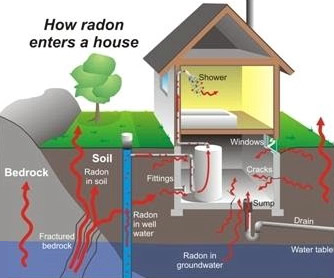The Risks and How to Protect Yourself from Radon
Radon is a naturally occurring gas found in the ground, water, and air. It has no colour, smell, or taste. High levels of radon gas present a health risk, particularly in enclosed spaces where the gas can accumulate. The most common points of entry into homes are cracks in the foundation, drains, and spaces around pipes. Radon is the second leading cause of Lung Cancer after smoking. When combined, the risk is especially high, increasing the risk of Lung Cancer from 1:20 to 1:3.
The only way to know what level of radon is in your home is to test for it. Health Canada’s Guideline recommends no more than 200 Bq/m3. This is the level above which you SHOULD take action to reduce radon levels in your home. While the health risk from radon exposure below the Canadian Guideline is smaller, there is no radon level that is considered risk-free.
People exposed to radon are at risk of developing lung cancer. Such risk is evaluated over a long term and depends on 3 factors:
- Level of radon concentration
- Duration of exposure
- Smoking habits
How can you protect yourself and your family from increased health risks from exposure to radon?

The Town of Grand Bay-Westfield has adopted the 2010 National Building Code which now requires all new dwellings must have a rough-in for a (future) sub-floor depressurization system. To encourage testing, the Town has adopted a program of providing all newly constructed homes with a free Test Kit which will record what the average radon level is in the home. If levels are detected above the Health Canada recommended limit of 200 Bq/m3, remediation should be considered. The new Building Code requirement applies to new construction only and does not contain retrofit requirements for radon gas. The offer to supply a free Test Kit is only available to new construction.
Radon Measurement Duration
Long-Term Measurement
Radon levels in a home or building can vary significantly over time. In fact, it is not uncommon to see radon levels in a home change by a factor of 2 to 3 over a 1-day period and variations from season to season can be even larger. The highest radon levels are usually observed during winter months. As a result, a long-term measurement period will give a much better indication of the annual average radon concentration than measurements of shorter duration. Long-term measurements are typically 3 to 12 months in duration. During this type of measurement, there are no requirements for the occupants to change their lifestyle once the measurement devices have been put in place. Health Canada recommends that the radon test performed in a home or public building be a long-term measurement. Health Canada does not recommend a test of duration less than 1 month, a minimum of 3 months is recommended and 12 months is optimum.
Devices for Long-Term Measurements
Alpha Track Detectors use a small piece of special plastic or film inside a container with a filter-covered opening. When alpha particles from radon and its decay products strike the detector, they cause damage tracks. At the end of the test period the container is sealed and returned to a laboratory for reading. The radon exposure duration of an alpha track detector is usually 1 to 12 months.
Measurement Locations
To provide a realistic estimate of the radon exposure of the occupants, all measurements should be made in the normal occupancy area of the lowest lived-in level of the home. The normal occupancy area is defined as any area occupied by an individual for more than 4 hours per day. Potential measurement locations include family rooms, living rooms, dens, playrooms and bedrooms. A bedroom location is preferred because people generally spend more time in their bedrooms than in any other room in the house. Similarly, if there are children in the home, lowest level bedrooms or other areas such as a playroom are preferred. The preferred device location is by an interior wall at a height of 0.8 m to 2 m (3 to 6.5 feet) from the floor in the typical breathing zone, however, at least 50 cm (20 inches) from the ceiling and 20 centimeters (8 inches) from other objects so as to allow normal airflow around the detector. Detector should be placed approximately 40 cm (16 inches) from an interior wall or approximately 50 cm (20 inches) from an exterior wall. Measurements should not be made in kitchens or laundry rooms. Kitchen exhaust fan systems and airborne particles (caused by cooking) may affect some measurement devices. Measurements should not be made in bathrooms because relatively little time is spent in a bathroom, high humidity may affect some measurement devices, and use of an exhaust fan may temporarily alter radon concentrations. Measurements should not be made in closets, cupboards, sumps, crawl spaces or nooks within the foundation. Radon concentrations in these areas are not representative of the concentration in the occupied area of the house.